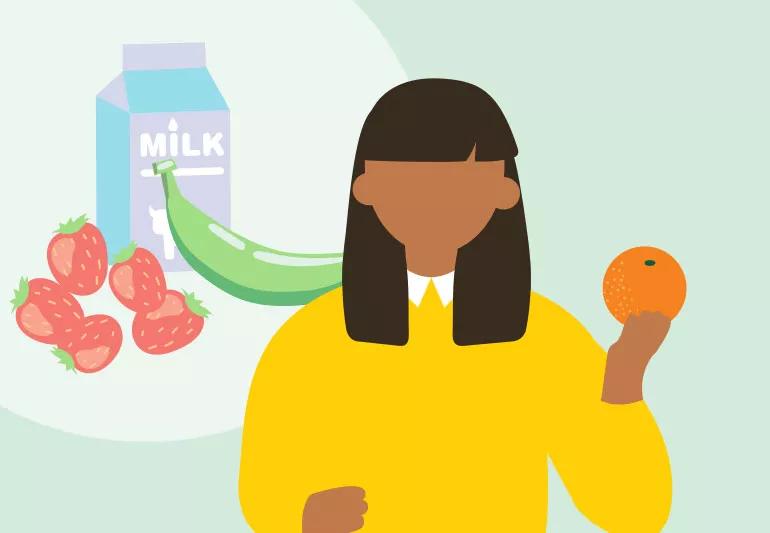Eat the right foods, and get plenty of sleep and exercise

When your kids are starting a new school year and heading back to the classroom, immunity is always a big concern for parents as cold and flu season looms ahead.
Advertisement
Cleveland Clinic is a non-profit academic medical center. Advertising on our site helps support our mission. We do not endorse non-Cleveland Clinic products or services. Policy
Kids and toddlers still need certain nutrients and vitamins to help boost their immune systems to aid in protecting against germs, either in the classroom or at home.
Knowing the best foods that can help boost immunity can assist you when meal planning for your child, whether that’s mealtime or an afterschool snack.
We spoke with registered dietitian Julia Zumpano, RD, about the best things for kids to eat and drink to help charge up those immune systems and avoid the typical coughs and sniffles of the school year.
In some cases, supplements can be an immune booster for kids. These are the supplements that are verified by third-party vendors, Zumpano says. “That means, another party has come in and checked that vitamin to verify its quality,”
But in general, “we really encourage food, not supplements,” Zumpano says. “Supplements aren’t regulated in the U.S. And because there’s no regulating body around these supplements, we’re not 100% sure a supplement is actually giving us what it claims.”
There are times, though, when supplements make sense. “Maybe you’re dealing with a picky eater or you’re struggling with a kid’s diet to get them the nutrients they need,” Zumpano says. “In those cases, supplements can help.”
Advertisement
While your kids can get most of their vitamin D by soaking up sunshine, that’s harder to do when using sunscreen, during the cooler months and during the school year. Foods that provide the highest amounts of vitamin D also aren’t on a kid’s typical menu. These include fatty fish (like trout, salmon, tuna and sardines) and mushrooms.
Fortified foods such as milk, yogurt, orange juice and non-dairy milk alternatives (like soy or almond milk) provide about 5% to 25% of the recommended daily amount of vitamin D, Zumpano notes.
However, she adds that as vitamin D is a fat-soluble vitamin, it’s absorbed best when taken with fat. Keep this in mind when your kids are consuming vitamin D. If a food already contains fat naturally (for example, fatty fish and whole milk), it’s not a concern. When a food doesn’t (like orange juice or some dairy alternatives), you’ll want your kids to pair it with a meal or snack containing fat.
A supplement might be necessary if the level of vitamin D in your child’s blood is below the normal range. But there’s some disagreement over the parameters of a normal range. Generally, kids are considered to have a vitamin D deficiency when their blood value is below 20. But some health data indicates that anything above 12.5 is considered safe, while others claim values below 30 are considered insufficient.
If you’re concerned your kid’s vitamin D levels are low, Zumpano suggests getting a blood test. You and your child’s pediatrician can determine the best next steps based on the results, including what dosage of a vitamin D supplement might make sense.
The amount of vitamin D you need each day depends on your age. Average daily recommended amounts for kids and adolescents are listed below in micrograms (mcg) and International Units (IU):
One of the most important minerals that can help a kid’s immune system is zinc, Zumpano says. “It’s typically found in protein-based foods. So oysters, red meat and poultry are some of the best sources.”
Beans and nuts are also a good source of zinc, she says, though the animal-based foods will deliver more of the mineral.
According to the National Institute of Health (NIH), the recommended daily intake of zinc for kids is:
But be careful — the NIH also notes it’s possible to have too much zinc, which can result in nausea, vomiting, loss of appetite, stomach cramps, diarrhea and headaches. According to the NIH, the upper limits of daily zinc intake are:
Advertisement
Zumpano says it’s also important to give kids a good source of probiotics. “Our gut harnesses a tremendous amount of bacteria. Some are healthy and some are not, and probiotics help create a better balance of that healthy versus unhealthy bacteria.”
Not only do a lot of yogurts contain probiotics, Zumpano points out, but it’s also a popular food with kids.
Fermented foods, she adds, are also a good source. These include:
Apple cider vinegar is a good way to work probiotics into a diet, too.
Additionally, you should be sure to get your kids prebiotics. Prebiotics are plant fibers that stimulate the growth of good bacteria. Excellent sources of prebiotics are:
Alpha-linolenic acid (ALA), which is the plant form of omega-3 fatty acids, is shown to fight illness, Zumpano says. Good forms of ALA include:
Zumpano also considers nuts and seeds as power foods for the multitude of nutrients they provide. Just to name a few:
Advertisement
This might sound pretty general, but these are always good standbys. Fruits and veggies provide various antioxidants, which protect cells from damage and disease.
Foods rich in antioxidants include:
“These power foods pack a punch when it comes to vitamins and nutrients like vitamins A, C, E, B2, B6, K, potassium, folate, magnesium, potassium and zinc,” Zumpano says.
And, of course, vitamin C is key to boosting immunity, and is available in various citrus fruits like oranges, lemons, limes and grapefruit. “Strawberries are great sources for vitamin C, too,” she adds.
It’s not just food that can help your kids stay healthy throughout the school year. In fact, Zumpano says that good sleep habits are essential for kids.
“Good, restful sleep is crucial for kids,” she says. “Sleep is when our bodies rest, regenerate and heal. It’s an essential part of keeping our immune systems functioning as best they can.”
Exercise is also important because physical activity can help keep your body resilient and more likely to fight off infections. “Make sure your kids keep their bodies moving,” Zumpano advises.
Advertisement
Another way to help kids be healthy is by minimizing stress and anxiety, an admittedly tall task given the ongoing pandemic and the effects it has on kids. From concerns about getting sick to the stress of being separated from friends, it’s a tough time for kids. Mindfulness can help.
“Deep breathing, meditation and communication can help pinpoint sources of anxiety and stress,” Zumpano says. “Talk to your kids about ways that you can work together to minimize any negative feelings they may be having during these uncertain times.”
Learn more about our editorial process.
Advertisement

Changes in your child’s emotions, behavior, sleep and appetite can all point to depression

Look for signs like withdrawing from social eating and not gaining weight — and get treatment early if possible

The need for sleep often takes a back seat for teens, but they need eight to 10 hours of sleep to stay mentally healthy, strengthen their brains and prevent injury

Integrating coping skills into your teen’s daily routine helps turn self-care into a lifelong healthy habit

Talking in the car, resisting the urge to judge and asking specific questions can help rebuild rapport

The vagina is full of healthy and unhealthy bacteria, so discharge can be normal or problematic

Parents must intervene, in a productive way

Solutions for real-life scenarios

The best parenting style balances enforcing rules and showing plenty of love

Tips include cutting back on sugar, focusing on exercise and managing stress

It can be harder to let go when you’ve invested time, energy and emotions — but it might be the healthier choice long term